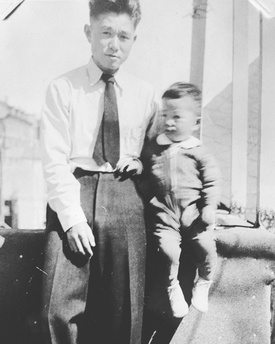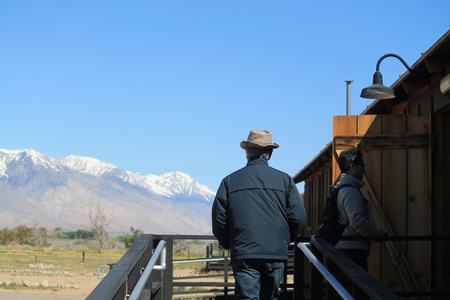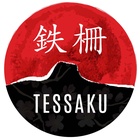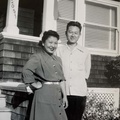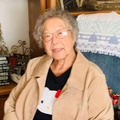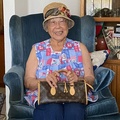What about the day you left for the assembly center?
All I remember was waiting at the train station on one side of a line. There were all these ruddy face Caucasians, all just looked red to me. All I remember is that these guys were holding guns. They weren’t pointing them, but what were we going to do? They didn’t even have to carry it. After that I noticed the difference. Why are we standing over here with name tags? They weren’t abusing us but it was still cruel, of course. Herding us into the middle of nowhere.
What are your most vivid memories at Santa Anita?
There were all these insects flying around. There was a horse fly. They were huge, like the size of a dragonfly. The first purchase my parents got at Santa Anita was a mosquito net to cover my bed. The showers were hard to get used to. We used those individual stalls for washing down the horses. So the nozzle was really wide, maybe a foot across and you had to pull this chain. My mother would lather me up and then pull the chain and the water would come down. It was like being drenched by a bucket, so that kind of frightened me as a little kid. And this is funny, well not funny. But army trucks would pull up and someone would shout down, ‘How many in your family?’ And they would just throw the toilet paper at them and you had to go pick it up. That lack of human dignity, it just went on and on.
Did you notice how the adults around you were acting?
Well one day one of my dad’s friends, Mr. Ota, came over to the stall. He was always around, even in San Francisco. I was playing with my Greyhound bus, like a small model of the real bus. So I’m playing with it in the dirt and Mr. Ota comes and I smile at him. And then he just kicks the bus and breaks it in half. I felt a tinge of, ‘What did I do?’ I felt guilt or something. But the next thing I knew and my dad is arguing with him. He saw it and asked, ‘What’d you do that for?’ So there’s nothing outstanding about that but it’s vivid in my mind. I’m sure he was just acting upon all that tension.
What do you remember about going to Topaz?
Not much except that it was a desolate, depressing place. Middle of nowhere. Obviously a perfect place to establish a camp. When the barracks were put up and we left Santa Anita, I remember it was hot as heck inside the train. We had to keep the shades down during the daytime. There were a lot of connections made between trains. The anti-Japanese hatred was going around, so when people were looking out from the exit and entrance to the pullman cars, objects were thrown so everyone had to clamor inside.
I didn’t comprehend what crime we were being accused of. But then I realized we must’ve done something, like why am I here? So that part of going into the barracks, it’s funny but after the stables in Santa Anita, it was like checking into the Fairmont Hotel. As primitive as it was. When we first moved into Topaz, there were pinewood boards on the floor but they had a separation. You could see the ground. Inside every room was a potbelly stove but there were cracks between the boards. So when the dust storms came, it would just come up into the room. We were given linoleum to cover the floors but it didn’t really help. There was a lot of white chalk there, and I heard it was alkaline or something. Something that’s unhealthy. So when the wind blew strongly, it would just whirl around the whole camp. And if we were stranded somewhere and blocks away from our home, we would have to hide and wait for the dust storm to subside.
How about Tule Lake?
Even when it was dinner time and we were waiting, there would be searchlights going around. Just like a concentration camp, these floodlights would be going all around the camp or sometimes they would lock in on a window. So there wasn’t privacy. Sometimes late at night I would go to the toilet and you had to walk in the middle part of the block. And sometimes a searchlight would come on from the perimeter and just follow you. So just like a prisoner, they were just watching you with these floodlights. But my parents eventually purchased a chanba, like a latrine.
In the wintertime in Tule Lake, it would really get socked in with snow. This place was a flatbed of a lake, so there were a lot of seashells. But it was so desolate and arid, you couldn’t grow anything green unless you really took care of it. So years later when I came out to Berkeley when I saw someone’s lawn, I thought it was the prettiest thing I ever saw [laughs]. And the people who were the dependents of the guards lived on the other side of the camp – we would see Caucasian kids playing. The biggest treat in my life in the four years was I went with my mom to see their living quarters. There were couches, it was nice. Our friend Susie Sakamoto was cleaning their houses and she gave us some See’s candy.
What were Grandma and Grandpa doing?
Grandma worked in the mess hall. But that was the problem. Since the administration were hakujins, you had to speak English in order to get a job. So that was the reason all these Kibeis didn’t have anything to do. They sat around. After a while, you’re bound to get radical, and if you have all of your education in Japan, it’s ingrained. All that propaganda and so on. In the beginning, Japan was pretty aggressive. For a while it looked like they would be a threat to the U.S.

How did Grandpa get involved with the politics and upheaval between the Kibeis and the Niseis?
There were two factions in Tule Lake. There were the radical Kibeis, educated in Japan. And the Niseis, the American moderates. And they were at each other. So the violence at Tule Lake stemmed from all of that. They were beating each other up. Grandpa was extremely angry. He thought the treatment was terribly unfair. And so he’d talk about it in Japanese, the court procedure of the U.S. law. It wasn’t even practiced at all. Two-thirds as you know were American citizens and they were still told to relocate. If you were along the West Coast and if you were of any Japanese ancestry, you had to relocate. They used the word “relocate.” But Tule Lake was a very violent place. Fighting, ganging up on people.
I had a classmate, Diane Tsukamoto, and they went after her father who served in the army and was the head of the JACL. See, the JACL was on the moderate side, advocating to volunteer for the U.S. army if you were the right age. And out of Tule Lake, I think only five or six volunteered. The rest of the 442nd were predominantly from Hawai’i. But because of that disagreement, the bickering was from that. The radical Japanese didn’t like the JACL.
So they were going to go after him, beat him up, but he fortunately wasn’t home at the time. The camp administrator allowed him to leave for his safety. So then he joined the army but he was already an attorney, that’s why he was the JACL president. Then he rapidly climbed and by the time he retired, he was a Colonel. So that was a pretty amazing achievement.
Do you think that the lack of parenting and upheaval affected everyone or just your parents?
Everyone, definitely. If anything my dad was on my butt quite a bit compared to the other fathers. Maybe because I was the only son. All of my friends had a lot of brothers and sisters.
The people who really suffered because of that condition were the children. They were the victims of this. And that was because fathers of a family behaved like they weren’t the head of a family. Not having that regimented work schedule; they weren’t doing anything. Sure they’re being fed three times a day, not doing anything. So they had forgotten they were the father figure. They would just sit and dine with their friends and didn’t really care about their children and look to see they were eating properly. Most of them, when they finished, had toothpicks in their mouth. I thought that was the ritual.
* This article was originally published on Tessaku on Octber 14, 2017.
© 2017 Emiko Tsuchida


